| ||||||
|
There are many other kinds of kimonos for women. When paying a formal visit, women wear homongi ("visiting kimonos"), which are covered entirely by a pattern. Tsukesage (decorated with patterns running up from the front and back hemlines to meet at the top of the shoulders, and patterns on the sleeves that meet at the tops of the sleeves) are for parties, tea ceremonies, flower arranging, and friends' weddings.
For casual wear, one can choose from such kimonos as komon, which are covered entirely by small, subtle patterns, and tsumugi, with brighter, more prominent patterns.
In summer, Japanese people enjoy lighting fireworks and attending summer festivals. At these times, they wear informal summer kimonos known as yukata. In the past, people also wore yukata at home after getting out of the bath, but now they are mainly a fixture of the summer streetscape, where they are worn by people young and old, male and female alike. Most yukata are made of cotton. Traditionally, they are patterned either navy-on-white or white-on-navy, but in recent years more colorful designs have emerged.
|
||||||
|
Photos (from top): The cool colors of a summer kimono (left) and a darker winter style; young people love to wear yukata to summer festivals. (courtesy of Hisako Nakatani) |

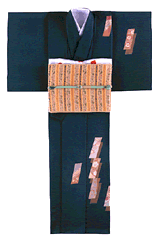
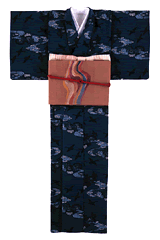
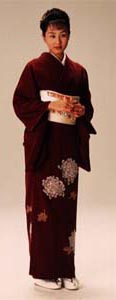
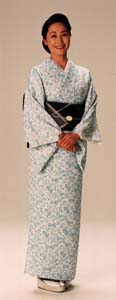 Whatever
the occasion-the first shrine visit of the new year, stopping in to
see an older person, or what have you--Japanese people always keep the
season in mind when deciding which kimono to wear. Pale colors such
as light green are appropriate for spring, while cool colors such as
lavender or dark blue or are good for summer. Autumn calls for colors
that imitate the hues of the turning leaves, and winter is the season
for strong colors like black and red.
Whatever
the occasion-the first shrine visit of the new year, stopping in to
see an older person, or what have you--Japanese people always keep the
season in mind when deciding which kimono to wear. Pale colors such
as light green are appropriate for spring, while cool colors such as
lavender or dark blue or are good for summer. Autumn calls for colors
that imitate the hues of the turning leaves, and winter is the season
for strong colors like black and red.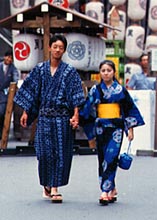 Although kimonos are no longer
everyday wear in Japan, people still like to wear them at various times
throughout the year. And when they do, they use the fabrics, colors,
and designs of their kimonos to express their love of the four seasons.
Although kimonos are no longer
everyday wear in Japan, people still like to wear them at various times
throughout the year. And when they do, they use the fabrics, colors,
and designs of their kimonos to express their love of the four seasons.